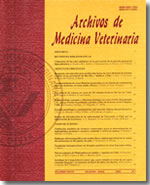Cecum-colic content of food and metabolism in the digestive tract of wild population black lizard (Ctenosaura pectinata) in Morelos, Mexico
Main Article Content
Abstract
Five digestive tracts of black lizards (Ctenosaura pectinata) from a wild population were collected in Morelos State, México, in order to identify the plant composition in the diet and the cecum-colic metabolism. Smears obtained from cecum-colic content were observed to register the presence of protozoa, bacteria and intestinal parasites. The average and standard deviation were estimated from the evaluated characteristics. The plants species Guamúchil (Phitecellobium dulce) and Huizache (Acacia farnesiana) were identified in the cecum-colic content. The vegetal content of the diet was constituted by fruits (62.9%), leaves (30.6%), buds (2.9%) and flowers (3.5%), dry matter basis. The cecum-colic portion was characterised by the concentration (mmol) of acetic (68.9 ± 10.6), butyric (11.98 ± 5.7) and propionic (9.04 ± 1.5) fatty acids, total fatty acids (89.9 ± 15), pH 7.45, and ammonia nitrogen concentration (7.4 ± 2.8 mg/dl). The microbiotic observed was the Nyctotherus spp protozoa. The total bacterial count ranged from 7 x 108 to 9 x 109/g, cellulolytic bacteria ranged from 9.2 x 107 to 3.5 x 108/g of cecal content. The parasites observed were nematodes identified as members of the Oxyuroidea superfamily, with 655 ± 265 eggs/g and 6,300 ± 329 adults/lizard. It is concluded that the fermentation of the cecum-colon region of the adult black iguana behaves similarly to that from herbivorous species, with fermentation being carried out according to the ingested food. Dietary concentration of crude protein was 14.5% and energy 2.193 (Mcal/kg), and they are animals parasited by oxiurids.

